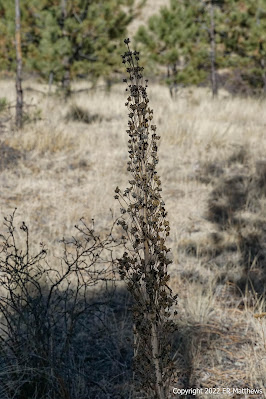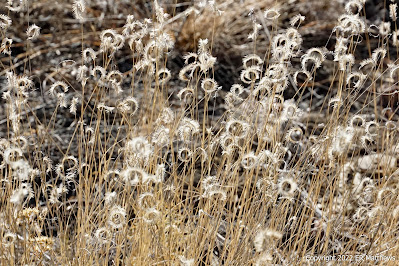On Tuesday of Thanksgiving week, Ann and I drove downtown to try out a highly regarded coffee house which proved to have both mediocre coffee and mediocre food, quite the disappointment after coffee on two previous mornings at Switchback Coffee Roasters. Over breakfast, Ann and I surfed the web for something to do and stumbled across Florissant Fossil Beds National Monument a few miles west of town. Why not, right? You only live once and it sounded like a road less traveled to us, something that we appreciate: seeing things that other visitors might skip.

We started climbing northwest out of town on US 24 up past Pike's Peak before striking almost due west at Woodland Park before continuing on nearly to the town of Florissant, where the park is located. We did not know that the Visitors Center was closed for repairs, which a ranger told us when we knocked on the door, trying to pay our entry fee, our annual pass left behind at home in my pickup. "Enjoy the park, no fee today!" he told us.
With the park situated smack in the middle of the montane zone at about 8500 feet of elevation and being mainly an upland grassland punctuated here and there with Ponderosa Pines and Aspens, we really expected to see a lot of animals grazing in the early morning sunlight, far from civilization. We were disappointed on the day to see only a Red Squirrel and a ground squirrel, along with a mere handful of birds. On the other hand, the scenery was gorgeous as we hiked around the park, going in and out of the trees and fields.
 |
Interior Steller's Jay with White Eyelid Not Found
on our Coastal Steller's |
We weren't sure what to expect at this fossil beds, but it turned out, it is not a barren rocky place at all where one can nose about looking for fossils. The main attraction here, the considerable beauty of the upland grasslands aside, is the petrified stumps of ancient sequoias, redwoods that no longer inhabit the planet. It appears that most have been discovered by tiny bits protruding through the soil and then excavated to reveal more of the stumps. The stumps were buried and ultimately preserved by an ancient pyroclastic flow, a massive lahar.
 |
| These Ponderosas Look Odd to Us |
I guess you'd say that the prime attraction Florissant is what is called the Big Stump, a petrified sequoia stump about 12 feet (3.5 meters) in diameter. It still bears a couple of broken off saw blades from an ill-advised attempt to transport the stump to the 1893 World's Fair in Chicago in the days before the stumps were protected. Scientists estimate that this tree would have been about 70 meters high, reaching above the little hillock in front of which the tree grew.
 |
| An Outcrop of Pike's Peak Granite |
 |
| Side View of Granite Bluff |
 |
| Typical Coloration of Pike's Peak Granite |
 |
| Stand of Mature Aspens |
 |
| Quite a Large Aspen for This Environment |
 |
| Mount Pisgah to the South |
 |
| Badger Mountain, left, and the Tarryall Mountains |
 |
| Up on the Hill |
 |
| Typical Ponderosa Form Here, Quite Alien to Us |
 |
| Pygmy Nuthatches, Most Commonly Seen Birds |
After spending a few hours walking around on this cold morning in the warm sun, we headed back into Colorado Springs to find a beer and some lunch. We would stop at a so-called brewery that we saw on our way out of town for a crappy beer that we left unfinished on the bar. From there we went down the street to Cerberus Brewing, where the head brewer Troy took pity on our plight, offering us taste after taste of his delicious beers. After a couple of hazies and some lunch, we returned to our B&B for a few hours. Later in the evening, we met the kids at Phantom Canyon brewing for dinner, where we had OK food and a crappy beer apiece. The quality of beer in Colorado Springs is not on average what we are used to back home in Bend.
































No comments:
Post a Comment